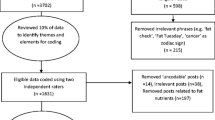Abstract
The National Cancer Institute (NCI) provides pertinent information about cancer prevention, treatment, and research advancements that is considered objective and accurate. NCI’s presence on social media is an example of a growing effort in promoting and facilitating audience engagement with evidence-based information about health and cancer. However, it is unknown what strategies are most effective for engaging audiences via this communication platform. To evaluate this important question, we analyzed data on posts, associated comments, and meta-data from official NCI Facebook page between July 2010 and February 2015 (end of data collection). Results show that audience engagement is associated with the format of cancer-related social media posts. Specifically, posts with photos received significantly more likes, comments, and shares than videos, links, and status updates. The findings have important implications for how social media can be more effectively utilized to promote public engagement with important public health issues.
Similar content being viewed by others
References
Chen Z, Koh PW, Ritter PL, Lorig K, Bantum EO, Saria S (2015) Dissecting an online intervention for cancer survivors four exploratory analyses of Internet engagement and its effects on health status and health behaviors. Health Educ Behav 42:32–45. doi:10.1177/1090198114550822
Korda H, Itani Z (2013) Harnessing social media for health promotion and behavior change. Health Promot Pract 14:15–23. doi:10.1177/1524839911405850
Silk KJ, Perrault EK, Nazione S, Pace K, Hager P, Springer S (2013) Localized prostate cancer treatment decision-making information online: improving its effectiveness and dissemination for nonprofit and government-supported organizations. J Cancer Educ 28:709–716. doi:10.1007/s13187-013-0515-8
Information needs of cancer patients and perception of impact of the disease, of self-efficacy, and locus of control—Springer. 2015. doi:10.1007/s13187-015-0860-x
Moorhead SA, Hazlett DE, Harrison L, Carroll JK, Irwin A, Hoving C (2013) A new dimension of health care: systematic review of the uses, benefits, and limitations of social media for health communication. J Med Internet Res 15. doi:10.2196/jmir.1933
Berkman ND, Sheridan SL, Donahue KE, Halpern DJ, Crotty K (2011) Low health literacy and health outcomes: an updated systematic review. Ann Intern Med 155:97–107. doi:10.7326/0003-4819-155-2-201107190-00005
Nutbeam D (2000) Health literacy as a public health goal: a challenge for contemporary health education and communication strategies into the 21st century. Health Promot Int 15:259–267. doi:10.1093/heapro/15.3.259
Schulz PJ, Nakamoto K (2013) Health literacy and patient empowerment in health communication: the importance of separating conjoined twins. Patient Educ Couns 90:4–11. doi:10.1016/j.pec.2012.09.006
Koskan A, Klasko L, Davis SN, Gwede CK, Wells KJ, Kumar A, Lopez N, Meade CD (2014) Use and taxonomy of social media in cancer-related research: a systematic review. Am J Public Health 104:e20–e37. doi:10.2105/AJPH.2014.301980
Hibbard JH, Greene J (2013) What the evidence shows about patient activation: better health outcomes and care experiences; fewer data on costs. Health Aff 32:207–214. doi:10.1377/hlthaff.2012.1061
Justice-Gardiner H, Nutt S, Rechis R, McMillan B, Warf R (2011) Using new media to reach Hispanic/Latino cancer survivors. J Cancer Educ 27:100–104. doi:10.1007/s13187-011-0267-2
Kendall H (2014) Harnessing the social web for health and wellness: issues for research and knowledge translation. J Med Internet Res 16. doi:10.2196/jmir.2969
Neiger BL, Thackeray R, Van Wagenen SA, Hanson CL, West JH, Barnes MD, Fagen MC (2012) Use of social media in health promotion purposes, key performance indicators, and evaluation metrics. Health Promot Pract 13:159–164. doi:10.1177/1524839911433467
Trevino LK, Lengel RH, Daft RL (1987) Media symbolism, media richness, and media choice in organizations a symbolic interactionist perspective. Commun Res 14:553–574. doi:10.1177/009365087014005006
Facebook (2015) Stats
Conflict of Interest
The authors declared no potential conflicts of interest with respect to the research, authorship, and/or publication of this article.
Disclaimer
Research reported in this publication was particially supported by the National Center for Advancing Translational Sciences of the National Institutes of Health under Award Number UL1TR001427. The content is solely the responsibility of the authors and does not necessarily represent the official views of the National Institutes of Health.
Author information
Authors and Affiliations
Corresponding author
Rights and permissions
About this article
Cite this article
Strekalova, Y.A., Krieger, J.L. A Picture Really is Worth a Thousand Words: Public Engagement with the National Cancer Institute on Social Media. J Canc Educ 32, 155–157 (2017). https://doi.org/10.1007/s13187-015-0901-5
Published:
Issue Date:
DOI: https://doi.org/10.1007/s13187-015-0901-5



